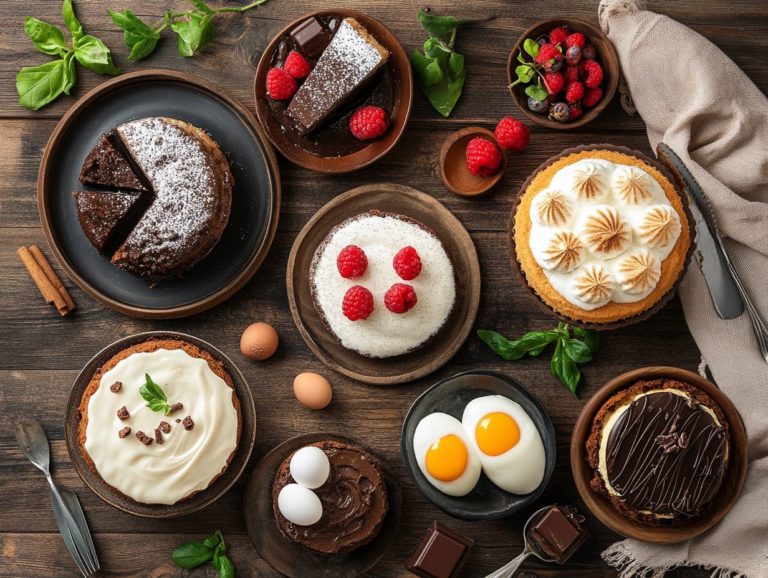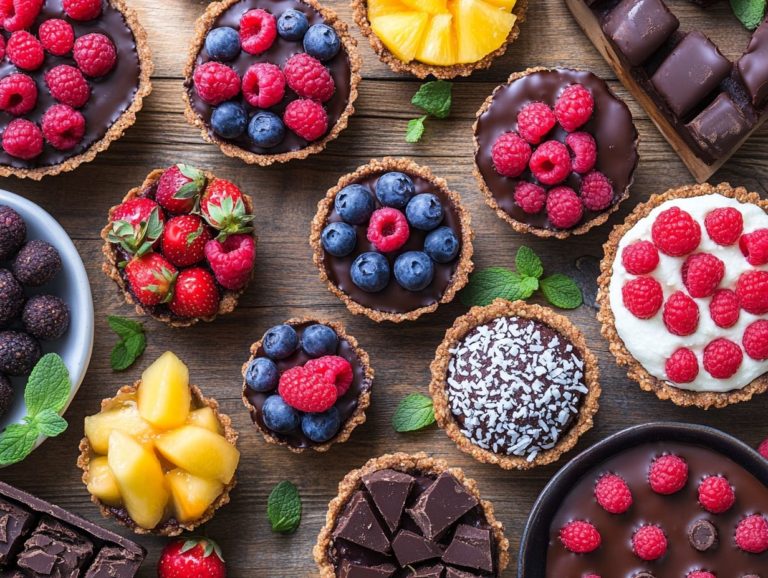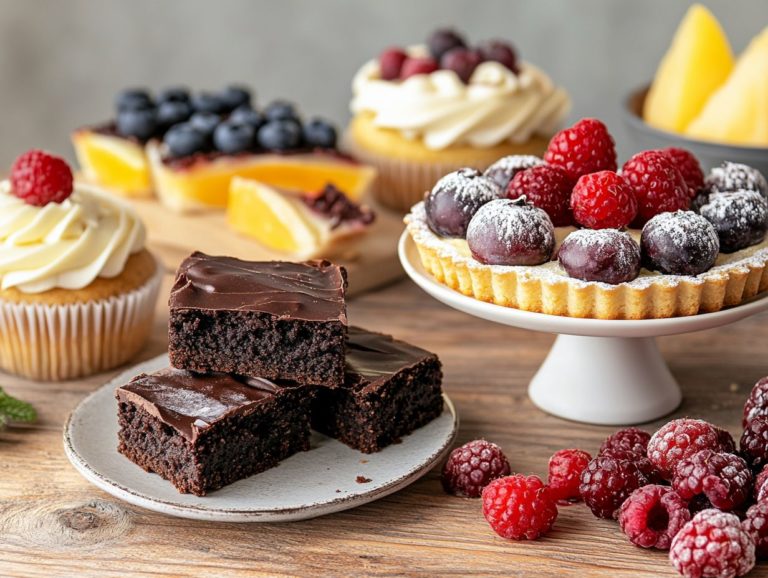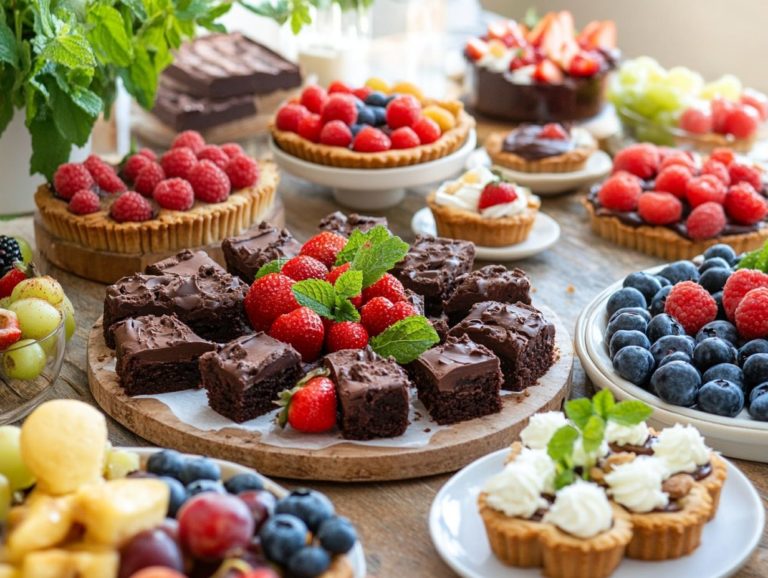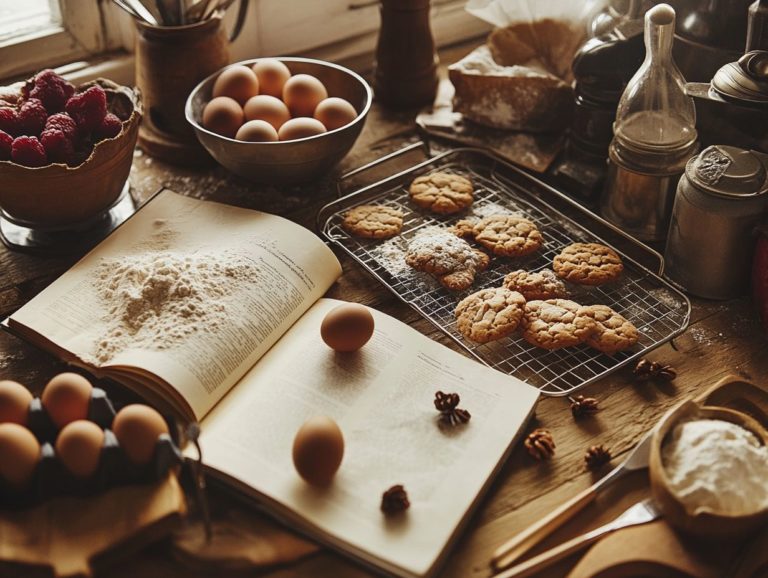What Are the Best Techniques for Dessert Layering?
Dessert layering is not just a technique; it s a magical way to turn simple treats into eye-catching delights! It transforms simple sweets into visually stunning and utterly delectable masterpieces, such as trifle recipes and parfait recipes.
By mixing different textures, colors, and tastes, you can elevate your desserts, whether it’s a chocolate pudding dessert or a strawberry shortcake, from the realm of the ordinary to the extraordinary.
This guide delves into the importance of layering and shares essential techniques that are perfect for beginners while also introducing advanced methods that will impress even the most discerning palates, featuring dessert ideas and dessert inspirations.
Whether you’re gearing up for a birthday dessert or simply seeking to indulge your sweet tooth, mastering the art of dessert layering will elevate your culinary creations to new heights.
Contents
- Key Takeaways:
- What Is Dessert Layering?
- Why Is Layering Important in Desserts?
- What Are the Basic Techniques for Dessert Layering?
- 1. Using Different Textures
- 2. Playing with Colors
- 3. Incorporating Different Flavors
- What Are Some Advanced Techniques for Dessert Layering?
- How Can You Make Dessert Layering Easier?
- 1. Preparing Ingredients in Advance
- 2. Using Templates or Molds
- 3. Practicing Proper Plating Techniques
- Tips for Creating Perfect Dessert Layers
- What Are Some Tips for Creating Perfect Dessert Layers?
- Experimenting with Different Combinations
- Frequently Asked Questions about Layered Desserts
- What are the best techniques for dessert layering, including for easy desserts?
- How do I use a piping bag for dessert layering, such as for Oreo cheesecake bars?
- What is the best way to use a spoon or offset spatula for dessert layering, especially for layered parfaits?
- How can I create interesting textures in my layered desserts, like in Napoleon cake?
- What are some tips for layering different flavors in desserts, like in dessert traditions?
- Can I use store-bought ingredients for dessert layering, such as in layered cakes?
Key Takeaways:
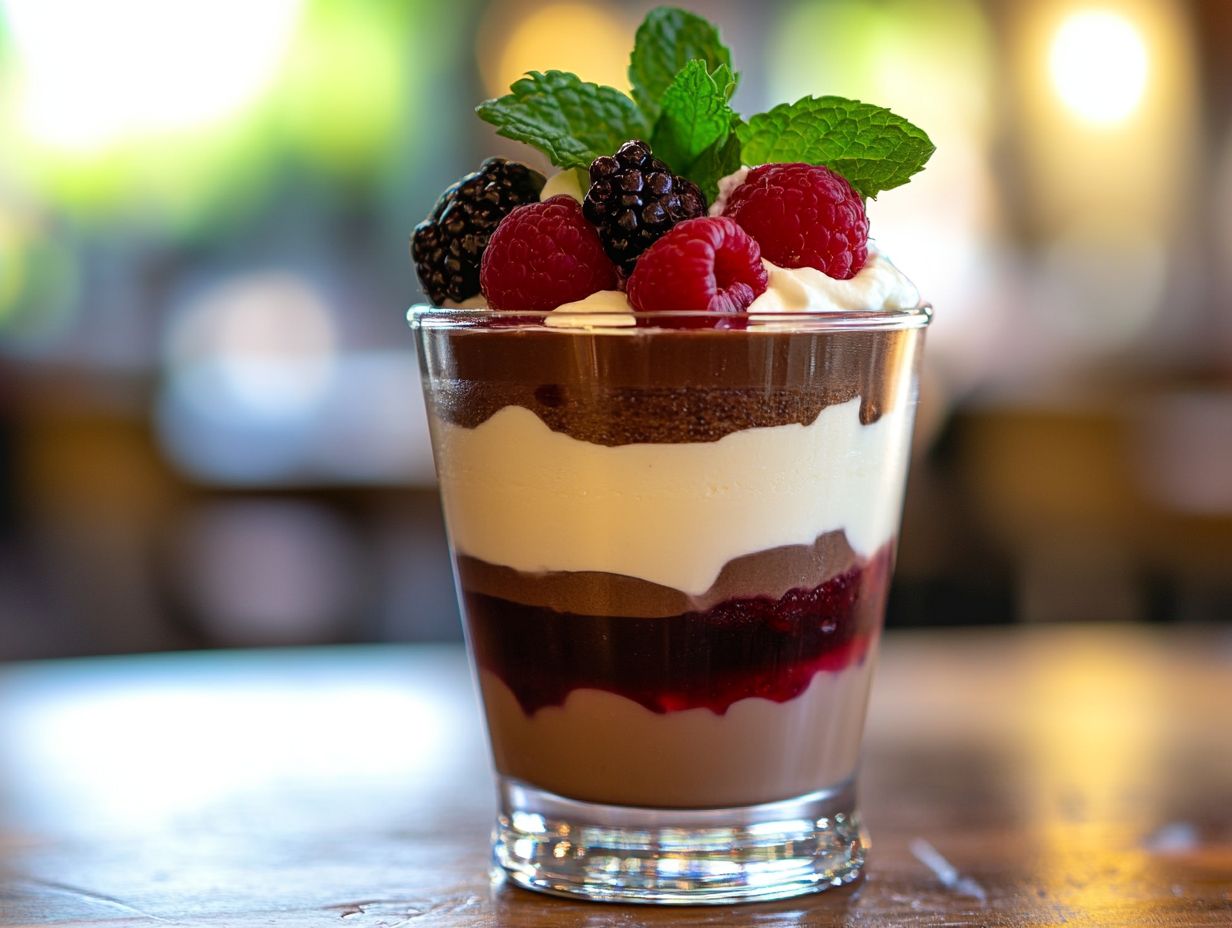
- Create contrast in your dessert layers by incorporating different textures, colors, and flavors.
- Advanced techniques like utilizing temperature, contrasting ingredients, and unique serving vessels can add visual interest to your dessert layers, creating gourmet desserts.
- Make dessert layering easier by preparing ingredients in advance, using templates or molds, and practicing proper plating techniques.
What Is Dessert Layering?
Dessert layering is truly an art form that transforms simple ingredients into visually stunning and delectable culinary masterpieces.
By skillfully combining elements such as chocolate pudding, whipped toppings, and fresh fruit, you can create beautiful, multi-textured dishes that elevate any meal, from homemade desserts to decadent pies.
Whether you’re exploring trifle recipes or parfaits, layered desserts offer a delightful array of flavors and textures that tantalize the taste buds while pleasing the eyes. This technique not only enhances the overall flavor profile of your creations but also crafts an impressive dessert table presentation that elevates any occasion, making it a favored choice for birthday celebrations and festive gatherings.
Why Is Layering Important in Desserts?
Layering desserts is essential, as it not only elevates the visual allure but also contributes significantly to flavor pairing and texture contrasts that truly delight the palate.
Each layer introduces a distinct flavor and texture, whether it s the indulgent creaminess of chocolate cheesecake or the airy lightness of whipped cream. These combinations create an enticing experience that keeps every bite intriguing.
Layered desserts such as tiramisu and banana pudding exemplify how contrasting textures can transform a dessert from the mundane to the extraordinary, making them critical for festive recipes and special occasions.
What Are the Basic Techniques for Dessert Layering?
Grasping the fundamental techniques of dessert layering is crucial for anyone aspiring to craft visually striking and delectable layered desserts.
By mastering these techniques, you can create impressive confections while also having the freedom to explore a variety of textures and flavors in delicious layers.
Employing different textures, experimenting with colors, and integrating diverse flavors can elevate your dessert to become both a visual masterpiece and a culinary delight.
Consider recipes like a rich chocolate cake layered with velvety whipped cream or dessert bars featuring a buttery cookie crust, or even the vibrant layers of Napoleon cake these examples showcase the art of layering beautifully.
Ready to impress your friends and family? Start layering your desserts today and watch their eyes light up!
1. Using Different Textures
Utilizing different textures in layered desserts is a vital technique that enhances your overall eating experience, creating contrast and complexity in each delightful bite. For instance, when you combine the smoothness of a custard filling with the crunchiness of a cookie crust or those magical cookie bars, you elevate the dessert’s appeal to new heights, crafting easy-to-make sweets.
Whether you savor the light, airy layers of a no-bake cheesecake or indulge in the rich, dense texture of a Mississippi mud pie, varying textures can make layered desserts feel more indulgent and satisfying. These dessert traditions often result in memorable culinary creations.
Incorporating elements like a fluffy mousse alongside a crunchy meringue can surprise your palate, leading you on a delightful journey of flavors and sensations. Picture a tiramisu, where silky mascarpone interacts with the robust texture of coffee-soaked ladyfingers, or a fruit trifle that beautifully layers creamy yogurt with juicy berries and crisp granola.
These delicious combinations will make your desserts unforgettable! They encourage you to explore your individual preferences, inviting you to infuse your own favorite textures into layered treats. So, whether it’s crunchy nuts, soft sponge, or velvety frostings, experimenting with these components can transform a simple dessert into something truly extraordinary. This recipe guide will help you navigate through various combinations.
2. Playing with Colors
Playing with colors in dessert layering not only elevates visual appeal but also crafts a sensory experience that captivates diners and enhances the overall presentation of your dish. Imagine vibrant layers, like those in berry-filled parfaits or colorful lemon and orange creamsicle bars, captivating the eye while giving a tantalizing hint of the flavors within, making them perfect for festive treats.
You can achieve those vivid layers by pairing tart raspberry coulis with sweet vanilla cream for a dazzling contrast, or blend rich dark chocolate with zesty orange curd to create an intriguing flavor profile. The juxtaposition of colors not only delights the palate but also elevates the entire dessert experience.
By utilizing natural food coloring from fruits or adding striking toppings such as whipped cream or a drizzle of chocolate, your desserts can transform into stunning masterpieces that are sure to impress at any gathering, especially when displayed on a dessert table.
The final presentation is essential; serving these creations in clear glass dishes allows onlookers to admire the intricate layers, heightening the anticipation of that first bite and enhancing dessert presentations.
Simple garnishes like mint leaves or edible flowers can further amplify the visual allure, ensuring that your desserts are not just a treat for the taste buds but a feast for the eyes as well. Don t miss out on trying these delightful combinations!
3. Incorporating Different Flavors
Incorporating a variety of flavors into your layered desserts is essential for crafting a diverse and enjoyable flavor profile that truly excites your palate. Consider flavor pairing combining the richness of peanut butter lasagna with the sweetness of banana pudding, for instance. This approach allows for unique combinations that surprise and delight dessert lovers.
Utilizing contrasting flavors, such as the tartness of fresh berries alongside the sweetness of a decadent chocolate pudding, creates an unforgettable layered experience that can elevate any dessert table, especially in layered cakes.
To further enhance these delightful combinations, think about adding elements like creamy mascarpone cheese infused with citrus notes to offset the richness. Imagine a layered trifle featuring tangy lemon curd and buttery shortbread that awakens your senses.
Encouraging your creativity as a home baker can lead to extraordinary discoveries. Experimenting with flavors like spicy ginger and sweet vanilla might yield uniquely satisfying treats that showcase your individual tastes. The possibilities are vast so dive in and let your culinary imagination soar, creating easy desserts that everyone will love!
4. Using Different Types of Desserts
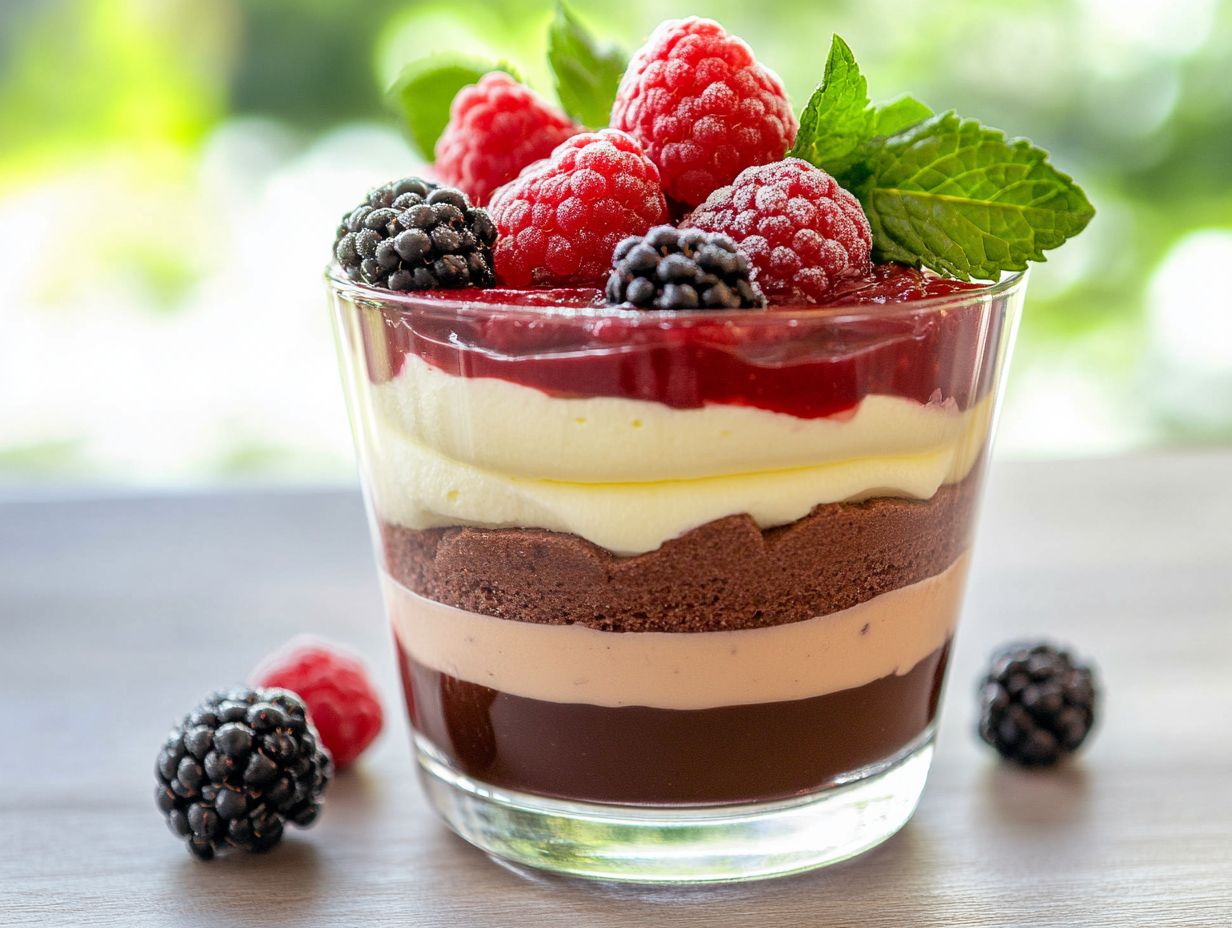
Using a variety of dessert types as layers allows you to create a rich tapestry of flavors and textures. This makes each bite a delightful surprise.
Layered desserts can encompass everything from icebox cakes and trifles to baked Alaska and indulgent pies. This offers you endless opportunities for creativity in homemade desserts.
Imagine combining layers of Oreo cheesecake bars with light, fluffy whipped cream. Now that s an irresistible treat that highlights the versatility of layered desserts, blending creamy layers and rich textures.
By incorporating elements like velvety chocolate mousse, luscious caramel sauce, or even tangy fruit purees, you can elevate your creations to new heights. Consider alternating layers of rich brownie fudge with zesty lemon curd; the delightful contrast will surely please the palate and create unique layer combinations.
As you craft these desserts, it s crucial to think about balancing sweetness and acidity. This ensures each bite remains harmonious.
For satisfying textures, mix creamy components with crunchy toppings, such as crushed cookies or toasted nuts. This adds an exciting surprise element that keeps the eater engaged and eager for more while savoring every delicious moment, making your desserts perfect for dessert presentations.
What Are Some Advanced Techniques for Dessert Layering?
Advanced dessert layering techniques can significantly elevate your baking skills, enabling you to create stunning and innovative treats that truly stand out.
By skillfully utilizing varying temperatures like pairing a warm chocolate cake with chilled cream you can enhance both flavors and textures, adding a delightful depth to your dessert experience. These techniques can turn simple sweets into gourmet masterpieces.
Incorporate contrasting ingredients, craft visual interest with elegant garnishes, and use unconventional serving vessels. This approach transforms simple desserts into gourmet masterpieces that leave a lasting impression on everyone who tastes them, making them perfect for summer cocktails and festive treats.
1. Utilizing Different Temperatures in Desserts
Utilizing different temperatures in your dessert layering not only elevates the sensory experience but also creates a unique flavor interplay that is both interesting and enjoyable.
Imagine layering a warm chocolate lava cake with a scoop of cold vanilla ice cream or a banana pudding this decadent contrast will tempt your taste buds like nothing else.
This dynamic combination showcases how temperature can transform a simple dessert into an unforgettable masterpiece.
Similarly, picture a warm apple crisp paired with a chilled scoop of caramel ice cream, or perhaps a delightful chocolate pudding dessert, where the warmth of the crisp beautifully contrasts with the creamy coldness of the ice cream, achieving a perfect balance.
To master the art of layering these temperature sensations, it s crucial to manage timing effectively. Serve those warmer components immediately after baking to lock in the heat, while keeping the colder components tucked away in the freezer until just before assembly.
By paying attention to texture and timing, you can effortlessly transform a classic dessert into a delightful experience that truly plays with the senses.
2. Incorporating Contrasting Ingredients
Incorporating contrasting ingredients in your dessert layering can lead to exciting flavor profiles. It adds delightful complexity to your creations.
For example, think about pairing the creamy richness of chocolate cheesecake with the tartness of fresh berries. This combination can tantalize your palate while providing a refreshing balance.
By strategically layering ingredients that offer contrasting flavors or textures, such as crunchy cookie crusts alongside velvety custard fillings or whipped topping, you can craft desserts that are both visually stunning and incredibly satisfying.
Consider the pleasant combination of sweet and salty by blending caramel swirls with a hint of sea salt, resulting in indulgent treats that achieve a perfect equilibrium. A classic example is combining hazelnut praline with ethereal whipped cream, or even a classic strawberry shortcake, where the crunchiness of the nuts beautifully complements the lightness of the cream, providing a layered contrast that elevates your dessert experience.
By layering these ingredients thoughtfully, with a keen eye for proportions and presentation, you not only highlight the individual elements but also create a cohesive, delectable masterpiece that leaves a lasting impression on those fortunate enough to indulge.
3. Creating Visual Interest with Garnishes
Creating visual interest with garnishes is an essential technique in dessert layering that elevates your presentations to a whole new level. Simple garnishes like fresh fruit, chocolate shavings, or edible flowers will instantly brighten up your desserts!
Thoughtfully placed garnishes can guide the eye to specific layers, highlighting the intricate details of delightful creations like trifle recipes and baked Alaska. This effectively boosts their appeal.
Beyond the basics, consider adding elements like flavored syrups, citrus zest, or crushed nuts to introduce additional dimension. An artistic touch can be achieved by varying the shapes and sizes of your garnishes, creating a more dynamic and inviting display.
Embrace your creativity by using geometric patterns or staggering heights with different garnishes, allowing your dessert to tell its own unique story. Experimenting with seasonal ingredients not only keeps your presentation fresh and exciting but also transforms each dessert into a feast for the eyes as well as a treat for the taste buds. Try adding flavor pairings to enhance the overall experience.
4. Using Unconventional Serving Vessels
Using unconventional serving vessels is a truly innovative approach to dessert layering that can elevate your dining experience to new heights. By choosing jars, glasses, or even edible vessels, you can beautifully showcase layered desserts while enhancing their overall appeal.
Individual servings in unique containers not only offer a modern twist on traditional presentations but also invite your guests to enjoy their desserts in a fun and interactive manner, making them ideal for events and gatherings.
Picture this: delightful trifles presented in mini mason jars or colorful shot glasses filled with parfaits, creating a vibrant display that tempts the palate. This method adds visual interest and encourages your guests to indulge at their own pace, savoring every bite.
Employing such creative dessert presentations, such as layered parfaits and dessert bars, elevates the dessert course, transforming it into a highlight of any meal. Whether you re hosting a summer picnic or a lavish wedding, think outside the box with serving solutions that captivate and engage everyone at the table, turning ordinary moments into extraordinary celebrations.
How Can You Make Dessert Layering Easier?
Elevating your dessert layering game begins with thoughtful planning and meticulous preparation, ensuring that each component is poised for a flawless assembly into a stunning final masterpiece. By prepping your ingredients ahead of time, utilizing templates or molds for uniform layers, and mastering proper plating techniques, you can effortlessly create impressive layered desserts, no matter your baking experience.
Whether you’re designing an exquisite trifle a layered dessert often made with cream, fruit, and cake an icebox cake, or a decadent layered cake, these strategies will streamline the process and elevate the overall quality of your culinary delights.
So, why wait? Start experimenting today with these layering techniques and impress your friends and family with your dessert skills!
1. Preparing Ingredients in Advance
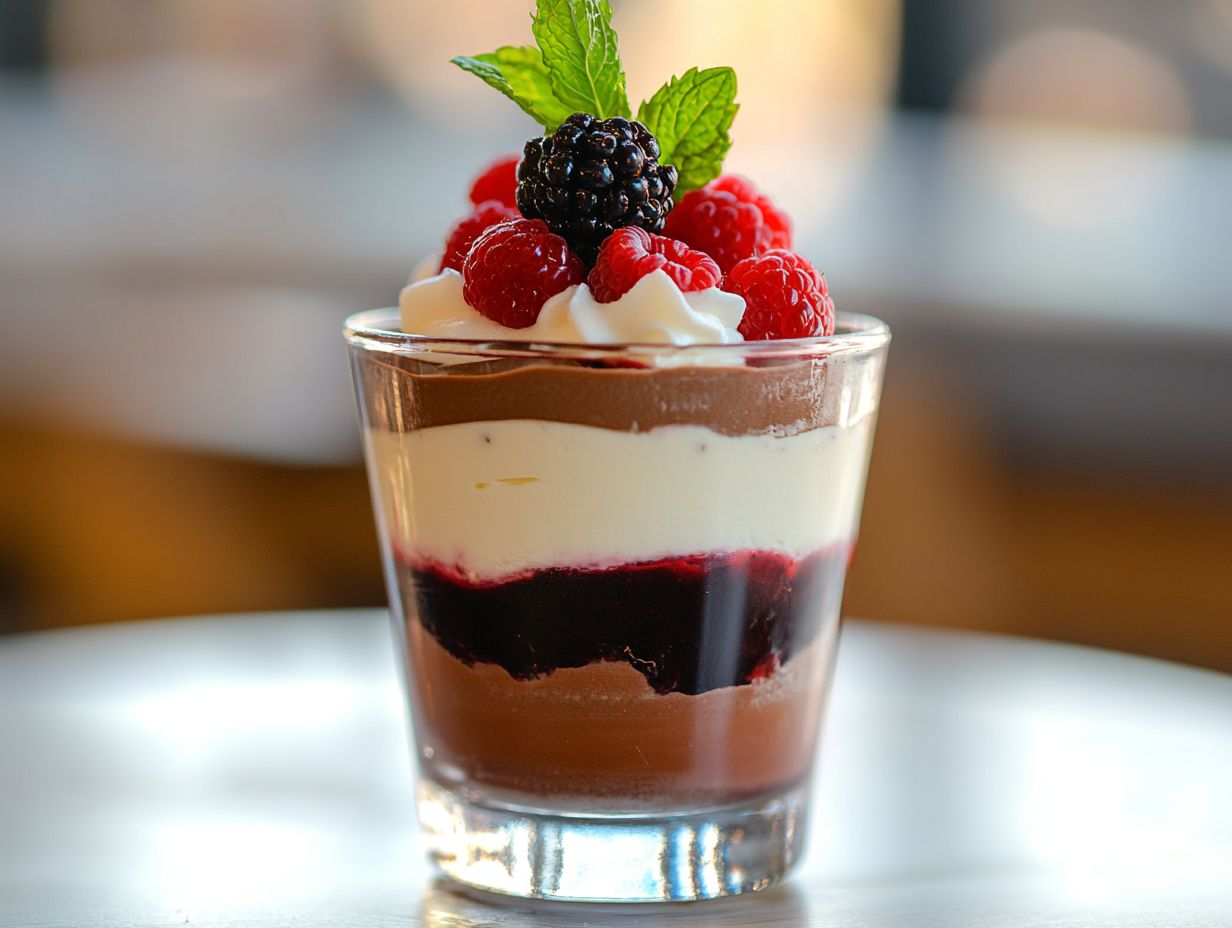
Preparing your ingredients in advance is one of the smartest time-saving strategies to simplify the dessert layering process. This ensures a seamless assembly experience. By pre-measuring and organizing all your elements creamy layers, cookie crusts, and toppings you streamline the entire process. This significantly reduces stress when it s time to put your masterpiece together.
This method not only boosts efficiency but also leads to more consistent and delightful results in your layered desserts. Think about using recipe guides to keep your process organized.
A practical approach is to batch cook certain components. For instance, consider whipping up large quantities of custard or whipped cream that can be stored in airtight containers in your refrigerator for several days. This guarantees peak freshness and allows those flavors to meld beautifully together.
Preparing components for no-bake cheesecake or orange creamsicle bars ahead of time can save you effort during assembly. Think about prepping your cookie bases in advance; by baking and crumbling them ahead of time, you ll save yourself precious moments during assembly. This is especially useful for layered desserts like Magic Cookie Bars or Peanut Butter Lasagna.
Employing proper storage techniques, such as using clear containers, helps you manage each layer visually. This makes it easier to select the right components quickly while ensuring your dessert looks just as irresistible as it tastes. This is especially helpful for complicated homemade desserts like Limoncello Tiramisu or Mississippi Mud Pie.
2. Using Templates or Molds
Using templates or molds transforms your dessert layering experience. These tools ensure consistent results in your desserts. With these at your disposal, you can effortlessly produce evenly shaped layers, whether you’re crafting cakes or parfaits, while minimizing the risk of a messy assembly.
This technique works wonders when creating intricate desserts like Napoleon cake, Blueberry Cheesecake Icebox Cake, or baked Alaska. It allows for precise layering that elevates the overall presentation.
Think about incorporating circular molds for those flawlessly round layers, or rectangular frames if you prefer a more angular aesthetic. Silicone molds are especially favored for their flexibility. They enable you to release your desserts with ease, preserving the integrity of those delicate layers.
Experiment with layered parfaits or parfait recipes to practice these techniques. Using templates can also streamline the process of cutting cake layers to size, ensuring uniformity throughout your dessert.
By exploring various shapes and designs, you can unleash your creativity while maintaining a sophisticated appearance. This transforms even the simplest ingredients into stunning layered masterpieces.
3. Practicing Proper Plating Techniques
Practicing proper plating techniques is essential for showcasing layered desserts in the most visually captivating manner. Thoughtfully arranging the layers, carefully drizzling sauces, and strategically placing garnishes can elevate a simple dessert into a stunning centerpiece. Mastering these techniques allows you to enhance the overall presentation, making desserts like trifle recipes, chocolate cake, and chocolate pudding truly irresistible at any dessert table.
To take the visual appeal up a notch, think about using colorful ingredients fresh fruits, edible flowers, or chocolate shavings to add depth and texture. Utilizing contrasting colors draws the eye and invites your guests to indulge their senses even further.
Don t forget to get creative with your serving vessels; choosing unique glassware or dishes that complement the theme of your dessert can make a world of difference. Use ideas from dessert inspirations to enhance your presentation.
Embrace the joy of playful experimentation with layers and toppings. This can lead to delightful discoveries and transform your gatherings into memorable celebrations of culinary artistry that everyone will cherish. For instance, adding festive treats or birthday desserts to your repertoire can make special occasions even more memorable.
Start experimenting with these techniques today to create stunning layered desserts!
Tips for Creating Perfect Dessert Layers
What Are Some Tips for Creating Perfect Dessert Layers?
Creating flawless dessert layers demands careful attention and a few essential tips that can elevate your layered desserts. Consider adding popular dessert ideas like Mississippi Mud Pie or chocolate pudding dessert to your must-try recipes.
Focus on proportions. This ensures each layer is balanced and flavors harmonize beautifully without overpowering one another. Experiment with a variety of textures and flavors while striking a delicate balance between sweetness and acidity.
Follow these tips to create extraordinary layered desserts that will impress everyone! These best practices apply across a range of recipes, from refreshing fruit desserts to exquisite gourmet creations, including popular icebox cakes and trifle recipes.
1. Paying Attention to Ratios
Paying attention to ratios is vital when crafting layered desserts. This ensures that each component harmonizes beautifully and contributes to a balanced flavor profile. If one layer is too thick, it can overshadow other crafted layers. For example, achieving the right balance between creamy whipped cream and dense chocolate cake results in a satisfying and delightful dessert. This principle applies whether you’re making banana pudding or a chocolate cheesecake.
To find the ideal ratios for various layers, consider experimenting with different textures and flavors. A classic example is a trifle, a type of layered dessert made with cream, fruit, and sponge, that melds sponge cake, fruit, and custard. The key is to prevent any single element from becoming dominant. Start with equal parts of each layer and adjust based on your taste preferences to achieve a delightful equilibrium. Trying different parfait recipes is another fantastic way to find your perfect balance.
Embracing the opportunity to try new ratios encourages creativity in the kitchen. This leads to unique desserts reflecting your individual palate like zesty lemon curd paired with luscious mascarpone or rich caramel layered with crunchy nuts.
2. Using a Variety of Textures
Incorporating a variety of textures into your dessert layers is essential for crafting a multi-dimensional dining experience that captivates your guests. The interplay between the crunch of cookie crusts, the creaminess of custard fillings, and the softness of whipped toppings greatly enhances a layered dessert’s enjoyment. Desserts like Mississippi mud pie and banana pudding effectively showcase this principle, transforming simple recipes into extraordinary indulgences. Even dessert bars can benefit from varied textures, making each bite intriguing.
To excite your palate, experiment with layers introducing unexpected elements, like the airy lightness of meringue or the delightful chewiness of toasted nuts. Your flavorful layers can encompass everything from rich chocolate ganache to vibrant fresh fruit coulis, each adding its unique touch to the overall texture.
Imagine a luscious cheesecake complemented by a layer of crunchy granola, or a smooth panna cotta beautifully paired with a tart fruit compote. Embracing culinary experimentation will enhance your presentation and awaken new dimensions of taste and satisfaction for everyone at the table. Delight in creating homemade desserts featuring creamy layers combined with various textures.
3. Balancing Sweetness and Acidity
Balancing sweetness and acidity is essential in dessert layering. Each component should contribute to a harmonious flavor experience. If you allow too much sweetness to take center stage, it can easily overwhelm the palate. However, just the right amount of acidity can brighten and elevate the overall taste.
For instance, think about incorporating tart fruits into a rich chocolate pudding dessert. This delightful contrast enhances the flavor profile. It makes each bite not only enjoyable but also refreshingly vibrant.
A lemon curd tart paired with a delicately sweet meringue is another excellent option. This combination beautifully illustrates how these elements can work together. The zesty zing of the lemon cuts through the soft sweetness of the meringue, resulting in a perfectly balanced treat.
Other desserts, like a berry and cream cheesecake, exemplify this principle as well. The tangy berries interact beautifully with the creamy, rich base. As a home baker, you are encouraged to experiment with unconventional pairings. Consider adding a splash of vinegar to a chocolate cake or incorporating citrus zest into your cookie dough. These small adjustments can introduce dynamic flavors that truly elevate the dessert experience.
Why not add a splash of summer cocktails for an exciting twist that will wow your guests?
4. Experimenting with Different Combinations
Experimenting with Different Combinations
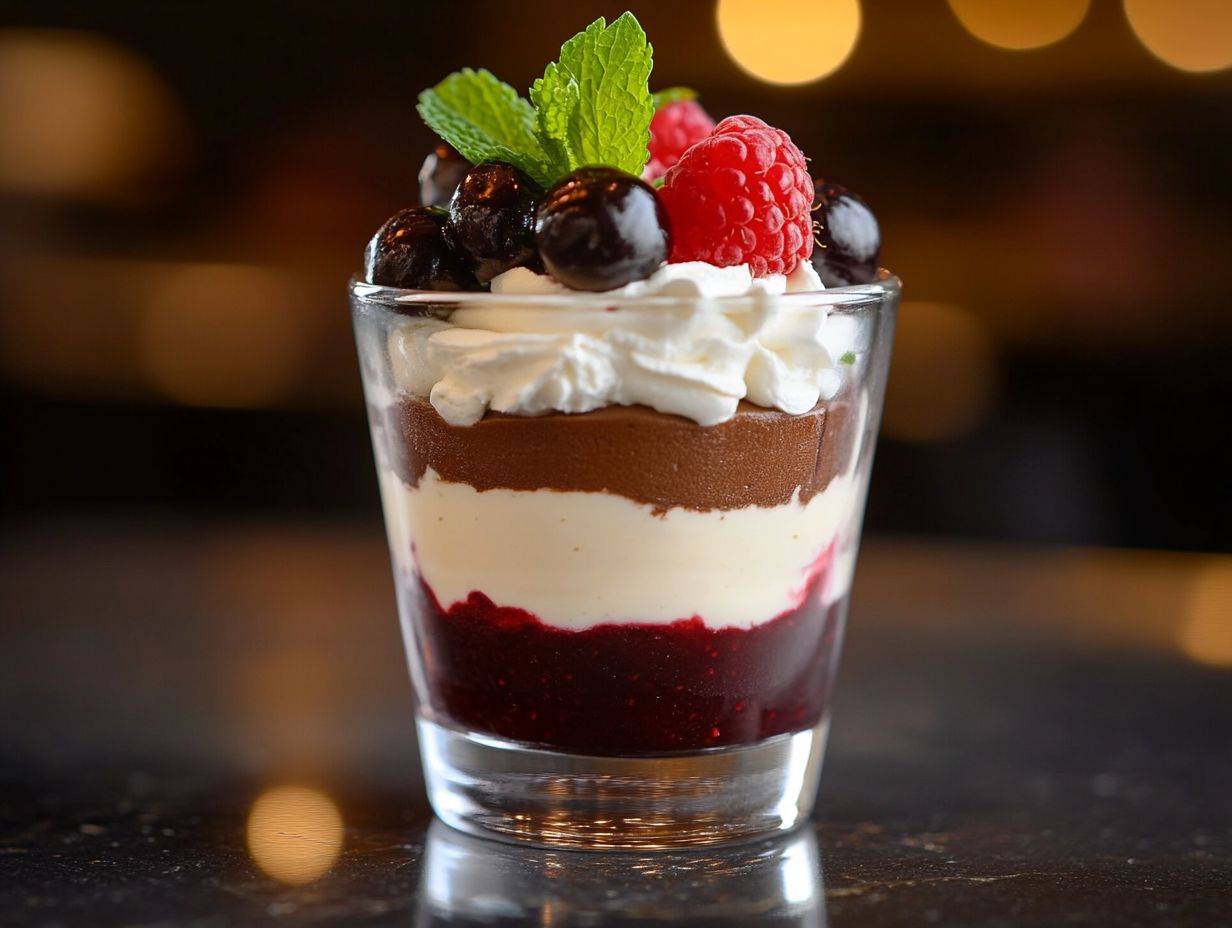
Experimenting with different combinations of ingredients and flavors opens the door to exciting and unique layered desserts. These treats are sure to surprise and delight you. By daring to mix elements like chocolate cake with orange creamsicle bars or layering various flavors of cheesecake, you can discover new favorites and expand your dessert repertoire.
Think about creating peanut butter lasagna or Oreo cheesecake bars for a twist on the classics. This creative exploration leads to impressive treats for special occasions and inspires innovative baking in your everyday life.
To make the most of your baking adventure, think beyond the conventional. Consider unusual pairings, like gingerbread crumbles with vanilla pudding or lavender-infused whipped cream with berry compote. It s all about achieving balance playing with textures and flavors can add a delightful twist to traditional layered desserts.
Always start with small batches to safely test your combinations. This way, you can fine-tune the ratios without worrying about waste. Who knows? You might just stumble upon a surprising harmony of tastes, such as peanut butter and banana pudding, that becomes a cherished favorite in your household!
Consider adding these inventive dessert ideas to your festive recipes collection. This will make your dessert table the highlight of any gathering.
Frequently Asked Questions about Layered Desserts
What are the best techniques for dessert layering, including for easy desserts?
Many techniques can help you create beautiful layered desserts. Some of the best include using a piping bag, a spoon, or an offset spatula. You can also experiment with different textures and flavors. For example, try layering custard filling with a cookie crust for a delightful contrast.
How do I use a piping bag for dessert layering, such as for Oreo cheesecake bars?
Piping bags are great tools for creating beautiful and precise layers in desserts. To use a piping bag, fill it with your desired filling or frosting. Gently squeeze to create even layers. You can also use different piping tips to create different designs. This technique is perfect for intricate desserts like Napoleon cake or any layered cakes.
What is the best way to use a spoon or offset spatula for dessert layering, especially for layered parfaits?
Using a spoon or a spreader is an excellent technique for creating smooth and even layers in desserts. Spread your filling or frosting in an even layer using the back of the spoon or the offset spatula. You can also use these tools for creating different designs and textures. This method works well for delicious combinations such as strawberry shortcake or s’mores.
Try out these ideas in your next baking session and share your creations with us!
How can I create interesting textures in my layered desserts, like in Napoleon cake?
Creating different textures can elevate your layered desserts. This makes them more visually appealing.
Try adding exciting textures to your desserts with crunchy toppings or by mixing creamy and crunchy elements. You can also add different cakes or cookies to enhance the experience.
What are some tips for layering different flavors in desserts, like in dessert traditions?
Layering different flavors adds depth and complexity. Use flavors that go well together to enhance your desserts.
Adding a touch of citrus or spice can balance rich flavors beautifully. Explore flavor combinations like chocoflan or limoncello tiramisu for a sophisticated touch.
Can I use store-bought ingredients for dessert layering, such as in layered cakes?
You can use store-bought ingredients for dessert layering. Pre-made cake layers and toppings save you time and effort while still creating delicious desserts.
Choose high-quality ingredients to ensure the best results. Even easy-to-make sweets like no-bake cheesecake can benefit from premium store-bought elements.

